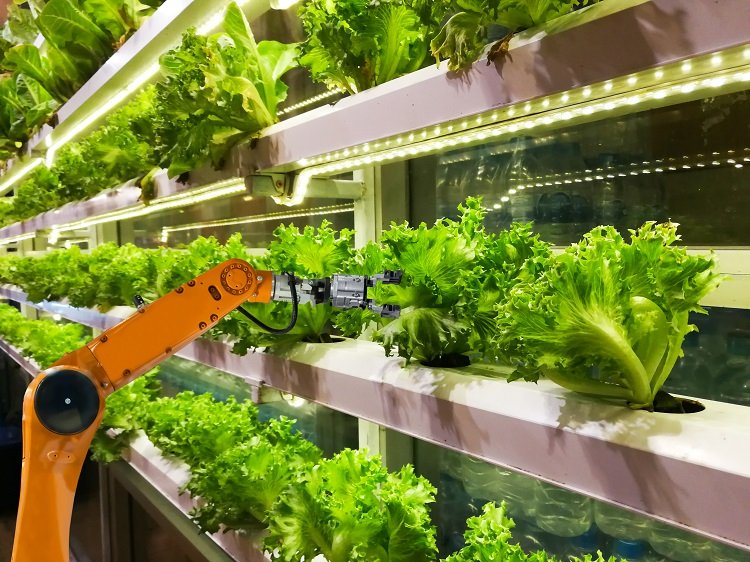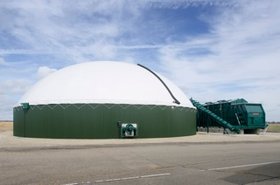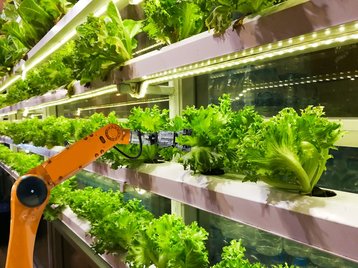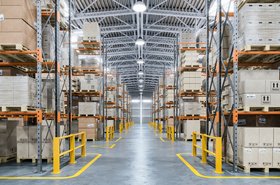As cities look to become healthier and more sustainable, indoor farming could grow more food in confined spaces and offer fresher produce to the hungry masses.
Rows of crops like strawberries, fresh greens, or even cannabis can be grown vertically for higher yields.
But indoor farms, like data centers, need large amounts of power and water. They also both need optimal temperature and atmospheric conditions, and generate heat - data centers through servers, farms through LED lighting.
Like data centers, indoor farms can fit into anything from shipping containers to massive warehouses, but efficiencies of scale mean both industries are better suited to large shell buildings.
As indoor farms expand, will they compete with data centers for space and power, or will the two industries coexist and collaborate?
Indoor farms a growth industry
As well as taking up less land and water, indoor farms grow better produce in otherwise impractical locations. A 2019 Cambridge Consultants report said vertical farming could increase crop yield and quality, while reducing food miles.
"As a grower, you're constantly responding to those environmental variables around you,” says Douglas Elder, head of pre-sales at UK firm Intelligent Growth Solutions (IGS), which provides modular vertical farm units called growth towers. “It's really important that you are able to control everything from the lighting, the temperature, humidity, CO2, all of those things that affect how a plant grows. You take control of it, then it's completely predictable and repeatable.
“[Indoor farms] offer more resilience to the food supply system, but also offer higher Editorquality produce where needed, and allow you to grow where you can't [grow outdoors].”
Take broccoli, typically a very low-cost vegetable. But in Scotland, companies have to spend large amounts of time and money transporting the plants from where they are grown. Equally, indoor farming could help in the Middle East, where many crops are imported.
The legal cannabis market is worth somewhere in the region of $20 billion a year in the US.
There is some overlap, but indoor farming is worth around the same per year globally, while vertical farming is estimated to be a market worth somewhere around $10 billion.
The indoor farming market is still in an early phase, with vendors hyping up their capabilities, while investors pump in large amounts of money.
“It's still fairly early but it's getting to that stage where it's starting to cross over into the industrial scale; there is a lot of money flying around in this space,” explains Elder. “There's a lot of talk, a lot of smoke and mirrors still going on with this industry. Now it's time for them to stop talking and actually start doing.”
Sepehr Mousavi, innovation research lead at Swedish indoor farming startup SweGreen, agrees it can be a ‘tricky market’ to navigate. Based in the DN Tower in Stockholm, SweGreen can trace its roots to early indoor farming firm Plantagon.
“Many of these actors talk about automation and use of artificial intelligence, but rather as buzzwords to be able to create a place for themselves in the picture and also the possibility of obtaining venture capital,” he says.
The indoor cannabis market is risky, says Michael Fluegeman, principal engineer at Touchstone Engineering Corp: “The clientele is a little different; if you've got people coming out of the black market, you've got speculators, you've got people with really no background in business and building or designing anything.
“They may have experienced growing some plants in their yard or in their bedroom but [large-scale growing] is quite a different animal.”
Fluegeman says the cannabis industry is applying technology and strategies from data centers, but he has experienced people who claim to have funding - only to find, with engineers at work, that the money isn’t there.
Once cannabis is legalized federally and the pharmaceutical industry is fully engaged, the US industry will rapidly mature, become more professional, and embrace ideas such as efficiencies, automation, and software-driven farming, he says.
In the future, there may also be indoor insect farming: Aspire Food Group is working on a project to create an indoor vertical cricket farming facility - in a controlled and automated environment.
Plant factories or organic data centers?
From the outside, a large indoor farm might look like a data center. Both need large amounts of floor space, both have high power requirements (though data centers more so) and both need ample water.
“You're trying to do the same function; you've got a lot of electrical systems generating heat, it's all about insulation and external control,” says Elder. “They are effectively big insulated boxes with their own HVAC systems that are trying to take advantage of free cooling where available, avoiding any sort of influences from additional heat loads from outside.”
Both data centers and farms require backup power in the event of primary power failure. Data centers need good airflow management and temperature control to keep servers operating efficiently, farms need it to ensure plants are healthy. Both farms and data centers need security measures - though maybe only cannabis facilities need the same level of security as a data center.
Early indoor farms reportedly used data center equipment, as specialist equipment wasn’t available. Net Zero Agriculture’s systems are inspired by IT rack designs and used in shipping containers. Many companies in the UPS and HVAC space such as ABB, Air2O, and Schneider will serve both sectors.
Standby generators and automatic power transfer switches are the same, says Fluegeman, and farms can learn from data centers’ skill at getting airflow where the servers need it: “Grow facilities have some similar challenges: If you starve certain areas of airflow, the plants are not going to do well.”
Grow facilities are beginning to customize cooling equipment to deliver what they need more cheaply, says Fluegeman: “Like anything else, it becomes cost-driven; when there's enough scale and quantity it makes sense for vendors to address a specific need.”
“A lot of facilities that I've worked on had very simple fans,” adds Jerry Poon, lead electrical engineer, Touchstone Engineering. “A lot of that comes from not having a knowledge of what [cooling equipment] is out there.
“But the cooling equipment has been getting more sophisticated and more customized. The customer base is getting thoughtsavvier in terms of using better and more complicated equipment, and it's evolving separately from the data center world.”
There are big differences between the sectors, of course. Where data centers need fiber and connectivity to the outside world, even highly-automated farms are more independent and need only the most basic broadband connections.
DCD is not aware of major data center pest problems either, though we’ve heard of the odd rat or cat - and in one instance, a deer - in data centers. By contrast, indoor farms need constant pest control to keep insects off the crop.
Lighting is often incidental to a data center, but indoor farms rely on LEDs to nourish and maintain crops. Most of their heat generation comes from lighting, often totaling around 70 percent of total energy use. They also need to ensure CO2 levels are steady to ensure plants are healthy, and need tighter humidity control than a typical data center.
IGS has a ‘virtual power plant’ for farms to more easily control the LED lighting, as well as the total power draw. Elder says it can be useful if colocated with infrastructure that has more consistent and critical power needs.
Farms don’t have the same uptime needs as data centers. Those energy-intensive lights are not always needed 24 hours a day, so their power requirements vary during the day and night. Such farms are less concerned about outages, as plants can cope better than servers if the power goes off unexpectedly.
“Plants have a natural resilience,” says Elder. “They're natural organisms that are used to these sorts of interruptions. With a longer growth cycle crop, if you switch the lighting off for two hours every two weeks unexpectedly, you're not really going to see much of an impact.”
Elder argues modern automated indoor farms are more like factories than data centers. “These are effectively plant factories at the end of the day,” he says.
They can use similar scheduling and handling machinery: Cambridge Consultants found most robots used in vertical farming have been repurposed from arm systems like those used in automotive production lines.
SweGreen’s Mousavi says factories could also help with areas such as predictive analytics, AI-led automation, and vision systems for diagnostics: “There is a lot of space to do more effective things around the use of robots and automation.”
Farms and data centers fighting for land and power?
The rise in e-commerce coupled with the Covid-19 pandemic drove up the need for warehouse and distribution space as people shopped online for delivery to their home. As people spent more time online and companies established work from home infrastructure, the need for data center space also surged, causing increased competition for prime real estate in urban areas.
Urban indoor farms are not in that competition, as most are relatively small scale. They need to have transport to distribute their crops, but they have more choice in location as they don’t need high-bandwidth fiber.
But as urban farms – especially vertical farms – become more common, this could change.
Cannabis grow facilities can have a floorspace in the low tens of thousands of square feet and power requirements around 1MW, but some can total more than one million sq ft. A 2016 study from the Lawrence Berkeley National Laboratory suggested legalized indoor marijuana-growing operations could use up to one percent of electricity in the US.
IGS’ Elder says his company’s vertical towers average a power draw of 100kW per pair. One project involves more than 100 towers, with power reaching the 5MW range.
Unlike data centers, however, there may be an upper limit to farms’ energy needs. Different crops need more power or automation, but Cambridge Consultants says vertical farms need around 20-70W/sq ft (200 - 700W/sqm), which is only one tenth of the 200-300W/sq ft (2,000-3,000W/sqm) a server farm burns.
While data centers will always push for greater density, there are limits to the density of plants an indoor farm can achieve, even when growing vertically. ISG’s Elder says LED efficiency gains mean energy density footprints may even go down.
We have heard of one early example of competition between horticulture and data centers. Jeroen Burks, CEO of Blockheating, noted how a Microsoft data center in the Netherlands was built on land previously allocated for use as an industrial-sized greenhouse.
Burks says greenhouses in the county can easily reach tens of hectares in size, and require multiple megawatts of energy to power.
Microsoft’s Holland-Kroon data center was challenged by a local agriculture and horticulture group, saying the industry “cannot spare a hectare” in the area.
The indoor market is less established than greenhouses, and still choosing location on price, says Touchstone’s Poon. “The farther out you go the cheaper the land power and water is.
“The data center world and cannabis are both power hogs, but the cannabis industry is a little bit behind, they're worried less about power quality, and more about just having the power capacity for their operations.”
Buying land on price leaves practical problems. Every cannabis project Poon has worked on had to ask the utility for increased electrical infrastructure: “They look for location, they look for size, but they don't think about the mechanical capacity, they don't think about the electrical capacity,” he says.
On one project, the lack of power left the farm running generators 24x7 as a long-term ‘temporary’ solution while waiting for a utility upgrade.
Collaboration and colocation
Some data centers are reusing waste heat through district heating schemes connected to homes or offices. But some are now looking at heating agriculture and horticulture infrastructure instead.
QScale plans to place greenhouses on its campuses in Quebec, Canada, and use the excess heat for agriculture.
“We want to contribute to the food autonomy of the province with a potential of 400 hectares of greenhouses for the first campus,” said founder Martin Bouchard. “In Lévis, we have adjacent agricultural land which is equivalent to 80 football fields, enough to produce 2,880 tonnes of raspberries and 83,200 tonnes of tomatoes.”
Green Mountain in Norway is providing heat to both a land-based lobster farm (see next feature) and a trout farm, allowing them to dispense with expensive water heating and recycling systems.
German data center firm Windcloud set up a similar scheme sending its excess heat to an algae farm. Researchers at Lancaster University are looking at modular data centers which dry coffee beans in markets such as Costa Rica.
In 2020, Finnish developer Yit and Blockheating of the Netherlands both offered heat to nearby greenhouses. In Blockheating’s case, the servers themselves were recycled OCP standard hardware from hyperscale facilities, delivering bare metal services, with excess heat piped to the greenhouses for crops such as tomatoes, cucumbers, and peppers.
US entrepreneur Daryl Gibson recently proposed the Eden Fusion Center; a tropical indoor forest that would be heated with data centers during the winter months.
Unlike greenhouses, indoor farms generally have a surplus of heat from their LEDs, so they are more likely to donate excess heat to district heating schemes than benefit from them, but there are still opportunities for indoor farms and data centers to cohabit, especially if the farms can be flexible on power requirements.
“It's not about using the surplus heat for vertical farming, but rather creating a smart energy system and connection between these two different units to lend the energy to each other and borrow it from each other,” says SweGreen’s Mousavi.
Kansas Freedom Farms says solar panels installed on its large-scale vertical farms could produce a surplus of power for on-site data centers and cell towers.
“We are quite often approached by data center developers to look at these opportunities,” says IGS’ Elder. “Typically there's spare capacity available that they want to utilize, but they want something that can be flexible.”
“It's a positive PR thing as well; doing something useful for a slightly different industrial application in the same space if there is spare capacity.”
In the Netherlands, Microsoft collects rainwater to cool its data centers, then sends the excess to nearby greenhouses. But water-hungry data centers might not always be willing or able to share.
“If you're producing greywater for a data center, maybe with some degree of purification, some of that could be repurposed for growing plants,” says Touchstone’s Fluegeman. “But for the most part, I think they want to locate them where you have plentiful fresh water.”
Some small farms want to locate by offices, restaurants, or similar spaces. SweGreen’s Mousavi thinks it could be a “win-win opportunity” for them to occupy redundant server rooms or old basement data centers that have been vacated as companies consolidate to colocation facilities or the cloud.
However, IGS’ Elder says the concept is good in theory, but there are practical challenges in multi-use buildings. Equipment can be expensive and under-utilized, while pest control needs management and the crop needs distribution.
“If it's going straight into a kitchen in that building, great. But if you're having to transport crops from distributed locations to central points, it starts becoming problematic.”
Edge agriculture
Regardless of colocation opportunities, agritech needs its own IT infrastructure, both at the Edge and via the cloud. Agritech startup Aerofarms has a 70,000 square foot facility in New Jersey with plants in vertical columns that climb 36 feet. The company uses Dell technology for its IoT gateway and on-site compute needs.
A Purdue University project is using robots to develop future agriculture automation systems, in a greenhouse heated by Digital Crossroads’ Indiana data center.
Blockheating also hosts a local university robotics project on the farm at its facility, says Burks. A robot travels through greenhouses making predictions on yield, while Blockheating provides the compute infrastructure while sending excess heat back into the greenhouses to keep the crops warm.
He notes, however, that the farm’s IT only uses one rack out of the 10 that are currently heating the farm, so it's unrealistic for a farm’s agricultural IT to provide all the heating it needs.
As farms use more automation and analytics, they may need more on-site compute, and produce more heat for their own use. But, as with other industries, much of this will be in the cloud.
IGS’ Elder says his company is keeping on-site compute infrastructure relatively low, as programmable logic controllers respond to a database of functions that can be programmed through the cloud: “That allows us to simplify the requirements on-site and minimize computer-based functions on-site that are typically more unreliable than a PLC.
“It's all cloud-based software that's actually driving those PLCs. We obviously have to have a stable Internet connection, but it is easier for us to manage sites remotely through cloud-based servers.”
SweGreen’s Mousavi says his company’s farm also uses PLCs, but is looking into developing more real-time solutions using 5G and Edge computing, with some unnamed partners in Sweden: “I can't name them, but you could guess for yourself.”
Mousavi adds the big opportunity could be expertise: “One problem from the vertical farming industry is many of these companies are run by people who are greenhouse experts. "They think [data centers] are irrelevant because they are focused on the production of greens.”





